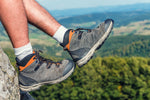
How to Determine the Best Fit for Hiking Boots
, by Ed Stone, 5 min reading time

, by Ed Stone, 5 min reading time
It’s important to pick the right shoe that provides the best ankle support before you embark on your hike. But how do you know what to look for in hiking boots? what constitutes the right size for a trail running shoe? And how can you assess the fit of your backpacking boots?
Read on to discover how to navigate the world of hiking boots and how to make sure your next pair of boots fit best for you.
The best mountaineering boots should be snug, but there should also be enough room in the toe area to provide maximum comfort when walking long distances.1
When testing a trail shoe, wearing thick socks will ensure optimal ankle support for any terrain you might encounter. Make sure to consider the right boot lacing techniques to utilize for the type of hiking you are doing. When considering new hiking boots, keep these factors in mind when assessing the fit:2
Heel area – When you first wear your hiking boots, you might experience a quarter-inch to a half-inch slippage around the heel area. This space in the backpacking boot will disappear once you break your boots in. If you continue to experience a gap after about a month’s use, insert a heel grip to ensure your boots stay snug.
Toe space – Look for men's safety toe shoes or safety shoes for women that have half an inch of space at the front of the shoe for your toes. This is particularly important because your feet will swell after a long hike and constrained toes are a surefire way to get blisters. Your boots should be snug in the arch and loose in the toes, so that your foot does not slide forward when hiking on a steep decline.
Tingling – You will know your boots are too tight if you experience a “pins-and-needles'' sensation that feels similar to when your foot goes to sleep. If you experience this \, try using thinner socks or get a larger size boot. To avoid this, it is recommended to walk around your home wearing your new boots for about a day before you use them on a trek.
Arch support – For those in need of arch support, it is advised to add an orthopedic insert to your hiking boot and get it fitted at the time of purchase. This will help to improve stability, support, and keep your foot in place so it is secure and comfortable.
Now that we’ve broken down the right fit for a hiking boot, here are considerations to make when choosing a pair for yourself.3
It's very common to have one foot be slightly bigger than the other, so check your boots for their length by trying them out with the laces tied.
Your heel area should be snug but not pushed up tight against the back of the shoe heel. Keeping in mind that you will mostly likely be wearing thicker socks with your boots and considering the potential for your feet to swell after long hikes.
You could also remove the insole and stand on it. The room between your longest toe and the tip of your insole should come up to half an inch.
You also want to ensure that your boots are not making the sides of your feet feel suffocated. If your boots are wider than snug, you’ll likely get blisters from the friction.
Lace up your hiking boots and walk around for a few minutes to ensure your feel can neither slide around nor are too tightly scrunched. Try to walk on an inclined surface as well.
Dreaded heel-list is never fun and is a common cause of cuts and blisters on the back of your ankle that results from oversized boots.
You can opt for thicker socks to avoid the heel lift. Sometimes your boot needs to be broken and this issue disappears. However, if your heel keeps coming out after a few weeks of use, then it's time to swap to a smaller boot size.
It's common to opt for cotton socks for breathability, but cotton is notorious for getting damp quickly, especially on long hikes.
The problem with damp socks is that this increases the friction between your foot and your boot, which can cause painful blisters. To avoid this, some people wear wool socks to wick the moisture from their feet, but this material can overheat your feet. As such, the best hiking socks are manufactured with a mixture of natural and synthetic fibers which can wick away moisture, reduce friction, keep your feet cool, and not wrinkle while keeping your feet in place.1 Because socks add extra material in the boot, it is important to make sure that your shoes fit with your hiking socks.
To ensure the perfect fit, opt for hiking boots that fit snugly around your feet but not too tightly around your heel or toes. If you’re also wondering, “how long do hiking boots last?,” we’ve got you covered in one of your latest blog posts.
If you’re looking for high-quality boots that can keep up with your active lifestyle, find your match at Boot World. We offer women’s and men's hiking footwear made with the highest quality materials and zonal arch and heel support. We even provide a sizing chart to ensure your boot is true to size. Hike happily with boots from Boot World.